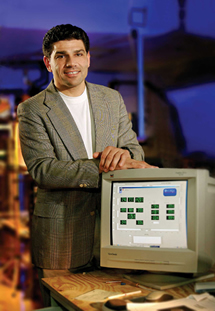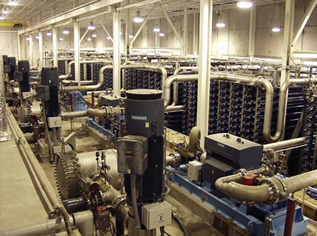|
|
Desalination Technology Taps Waste Heat From Power Plantsdownloadable pdf “In the future, we have to go to desalination because the freshwater supply at the moment can just barely meet the demands of our growing population,” says James Klausner, a UF professor of mechanical and aerospace engineering, whose research was funded by a $200,000 grant from the U.S. Department of Energy.
“We think this technology could run off excess heat from utility plants and produce millions of gallons each day,” said Klausner, lead author of an article on the system that appeared in the December issue of the Journal of Energy Resources Technology. He co-invented the technology with fellow UF mechanical engineering Professor Renwei Mei. More than 7,500 desalination plants operate worldwide, with two-thirds of them in the Middle East, where there often is no other alternative for fresh water, Klausner said. The technology is less common in North America, where residents get less than 1 percent of their water from desalination plants from plants located mostly in Florida and the Caribbean. The need for desalination is likely to grow, however, as the population increases and residents consume more fresh water. In Florida, for example, desalination has been touted as one solution for metropolitan areas where freshwater resources are becoming ever more scarce. Most commercial desalination plants now use either distillation or reverse osmosis, Klausner said. Distillation involves boiling and evaporating salt water and then condensing the vapor to produce freshwater. In reverse osmosis, high-pressure pumps force salt water through fine filters that trap and remove waterborne salts and minerals. Boiling the vast amounts of water needed for the distillation process requires large amounts of energy. Reverse osmosis uses less energy but has other problems, including mineral buildup clogging the filters. That’s the main technical issue plaguing the largest desalination plant in the United States, Tampa Bay Water’s $108 million plant in Apollo Beach. Although it was supposed to produce 25 million gallons of freshwater each day, the plant, beset by technical and financial problems since opening in 1999, currently is shut down. Employing a major modification to distillation, Klausner’s technology relies on a physical process known as mass diffusion to evaporate salt water. Pumps spray salt water warmed as a by-product of power plant cooling processes into the top of a diffusion tower — a column packed with a polyethylene matrix that creates a large surface area for the water to flow across as it falls. Other pumps at the bottom of the tower blow warm, dry air up the column. As the trickling salt water meets the warm dry air, it evaporates. Blowers push the now-saturated air into a condenser, the first stage in a process that forces the moisture to condense as freshwater.
By tapping warmed water plants have used to cool their machines to heat the salt water intended for desalination, utilities can turn a waste product into a useful one. Klausner has successfully tested a small experimental prototype in his lab, producing about 500 gallons of freshwater daily. His calculations show that a larger version, tapping the waste coolant water from a typically sized 100-megawatt power plant, has the potential to produce 1.5 million gallons daily. The cost is projected at $2.50 per 1,000 gallons, compared with $10 per thousand gallons for conventional distillation and $3 per thousand gallons for reverse osmosis. To be cost effective, the desalination equipment would have to extract as much heat as possible from the coolant water, so it would need to be incorporated into the plant’s design, he said. Also, a full-scale version of the mechanism would require a football field-sized plot of land, likely to be expensive in coastal areas where power plants are located, Klausner said. Presumably a utility would sell the freshwater it produces, recouping and then profiting from its investment, he said. Klausner said a miniature version of the full-scale system could be run using solar or other forms of heat, which might be useful for small towns or villages. The university has applied for a patent on the technology and is seeking a corporate partner to bring it to the commercial market. James Klausner Aaron Hoover |


